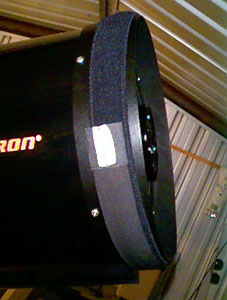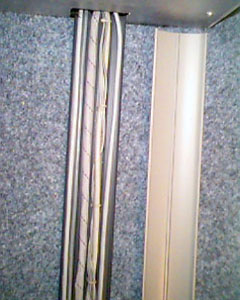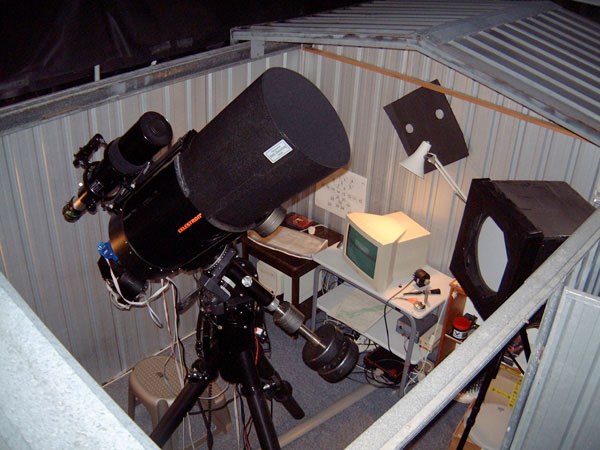 TSO is a small observatory setup for digital astrophotography and video but is also used for recreational observational astronomy. It's all recreational really. Images from TSO have been published in national and international publications. Images and video have been used for various television broadcasts. This page details the equipment currently installed. Previously equipment installations used for taking various images on the TSO webpages can be seen by using the button on the leftside button bar. |
This page is the fourth edition of the ever increasingly ineptly named "Tin Shed Observatory Page" and covers the equipment installed in it. |
The Telescope
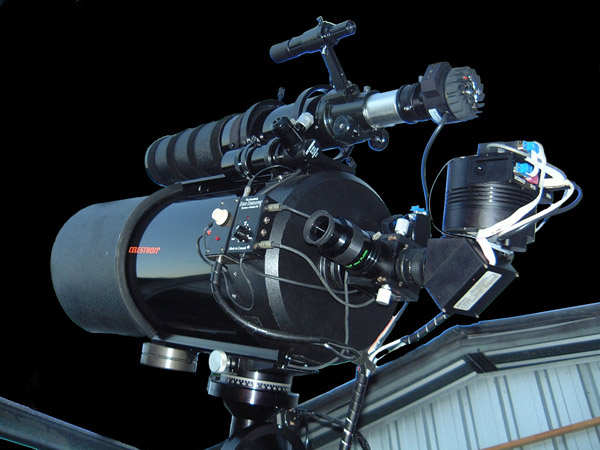
The main scope is a Celestron Schmidt-Cassegrain Telescope (SCT) with an 11" primary mirror and a focal length of 2.8 metres. Riding on top is a Synta 102mm f5 with Meade 2x barlow, William Optics minus violet filter and ST5c guide camera at 1000mm.
The Telescope Mount
|
|
The main mount is a Losmandy G11 (see makers section) with a carrying capacity of 60lbs (28kg). The mount is controlled by the Astrometrics Sky Walker II telescope control system. The SWII is a very robust and well supported system. The ST-10 power supply is strapped halfway up one of the tripod legs with velcro straps to try and extend the reach of the power cable to the camera. The Sky Walker hand controller, with the 4 red buttons provides limited controls, but the fully-featured Skyguide software running on the main PC provides complete Goto control, hand-paddle functionality and system feedback. Average weight on the mount is approximately 25kgs. |
Imaging System
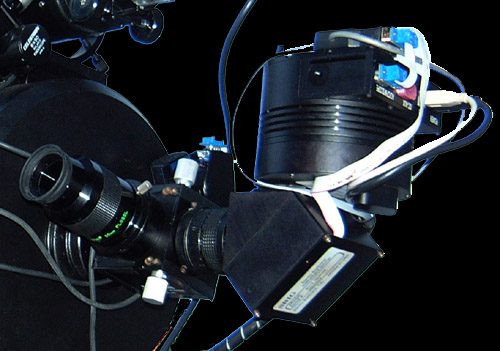 |
The imaging train consists of: Meade 2" flip mirror, f6.3 focal reducer (sometimes), AO7, CFW8, ST10xe |
Secondary Scopes
 Synta 102mm, f5 |
|
The f10 is from a local retailer of things astronomical called Star Optics. This is very nice achromat optically and shows a classic airy disk and diffraction pattern at focus. Being an achromat it does display an unobjectionable purply-blue halo at high power which is somewhat alleviated by a William Optics Minus-Violet Filter. Similarly, the f5 Synta (from Andrews Communication) is an excellent scope.
Either scope is held onto the C11 by 5" Losmandy rings and accessory rail and with minimal flexure. The intention is not to use these scopes for guiding but for wide-field imaging although they are used for guiding when a guide star is not available, which is usually the case when Hydrogen Alpha imaging through the C11. Normally, guiding is planned by pre-selection of guide stars using the ST10 reticle in TheSky and the ST10/AO7 are used to guide. For Hydrogen Alpha wide/field imaging through either of the refractors, the C11 is used as an on-axis guidescope with the Pixcel 255 camera at prime focus (2800mm). |

|
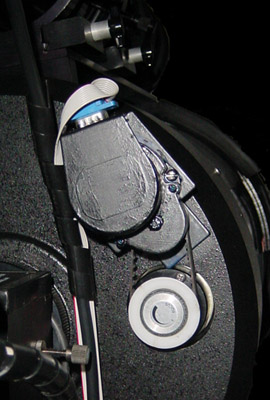
|
Dew Control
|
|
|
Light Box for Flat Field calibration frames

12" Light box made from instructions in the book Astronomical Image Processing | 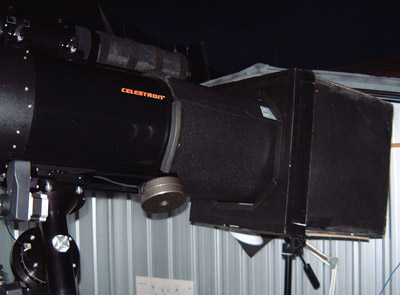 The 12" Lightbox was made from the instructions in the book Astronomical Image Processing, by Richard Berry and Jim Burnell (see the software links). Aligning the lightbox with the scope is simplified by mounting it on a camera tripod. This gives enough flexibility to easily and accurately align the telescope with the lightbox for taking flatfield images to be used when calibrating the raw images. One of the Red LEDs is visible at the top-left of the lightbox. There is a red LED positioned next to each bulb so they can easily be checked. All four bulbs need to be working for correct flat fields to be obtained.
The 12" Lightbox was made from the instructions in the book Astronomical Image Processing, by Richard Berry and Jim Burnell (see the software links). Aligning the lightbox with the scope is simplified by mounting it on a camera tripod. This gives enough flexibility to easily and accurately align the telescope with the lightbox for taking flatfield images to be used when calibrating the raw images. One of the Red LEDs is visible at the top-left of the lightbox. There is a red LED positioned next to each bulb so they can easily be checked. All four bulbs need to be working for correct flat fields to be obtained.
|
Ok it's a table in the corner rather than a center. More of a trolley. On it sits ... a Pentium 1Ghz PC that controls telescope tracking, pointing and imaging systems and connects the observatory to the house (and the world).
|
|
This computer controls telescope focus, pointing, camera control, guiding and image capture. A 12vdc 11-amp regulated power supply is beneath the computer and provides 12vdc to the entire scope and powers;
the finder reticle, guidescope reticle, Kendrick Dew System, Sky Walker II and motors. |
Local Area Network and Internet Gateway
The observatory computer is connected to a 100Megabit TCP/IP network. Files can be transferred from the observatory to the main computer at any time and the telescope and cameras are controlled remotely with the WinVNC remote control software (free from AT&T). The observatory is connected to the world via an internet gateway on the host machine inside the house. The observatory computer is synchronised with the U.S. Naval Observatory online Nuclear Clock before every use.
Wiring
|
|
|
|
| 12 vdc from the 11amp power supply runs to the scope and connects to a custom-made power box that has six RCA connectors. These can be used for powering any 12vdc device at the mount. It has two power input channels to allow two different power supplies to be used if needed. The single cable shown at top, runs 12vdc from the mount to the scope. | The power distribution box on the left is a custom-made splitter and voltage converter. It provides two 0-3vdc variable outputs for the finder scope illuminated reticle and Meade guide reticle and also has a 5vdc and four 12vdc outputs. The Robofocus, Dew Controller, Finder and Reticles all take power from here. |
Equipment List and Manufacturer Links
| Main Scope | Celestron C11 27.5cm @ 2750mm (f10) Schmidt-Cassegrain telescope. |
| Secondary Scope |
Star Optics (Synta). 10cm @ 1000mm (f10) Achromat Refractor Andrews Communications (Synta) 10cm @ 500mm (f5) Achromat Refractor |
| Finder Scope | Celestron 50mm Right Angle finder with illuminated reticle |
|
Mount |
Losmandy G11 28kg carrying capacity. |
| Telescope Control | Astrometric Instruments Sky Walker II. |
| Main Camera | SBIG ST10xe 2184x1472x6.8um Kaf-3200e CCD. |
| Guide Camera | SBIG ST-5C (Pixcel 255) 320x200x10um TI-TC255 CCD. |
|
AO |
SBIG AO7 Adaptive Optics Unit |
|
Filters |
SBIG Dichroic Filter Set w/IR rejection. |
| Filter wheel | SBIG CFW8 Motorised Filter Wheel |
| Focus Control | Robofocus Motorised Focusing system |
| Dew Control | Kendrick Dew heater system |
|
Polar Alignment Scope |
JMI G11 Illuminated polar alignment scope. Online Instructions |
Observatory Software
| Operating System | Microsoft Windows 98 |
| Telescope Control | SkyGuide SkyWalker II control software |
| Camera Control | Maxim DL CCD Camera Control Software. |
| Planetarium | TheSky V5L4 Planetarium and Telescope Control software |
|
Time Accuracy |
AtomTime Synchronises the PC clock with an online atomic clock. |
|
Image Processing |
Mira AP Version 6 AIP4Win Astronomical Image Processing |
|
Observatory Remote Control |
Win VNC Remote Control Software |
Equipment Problems
I was disappointed with the mounts tracking performance soon after installing it. It still doesn't track as well as I would like but it's a long story. Read about it here on the G11 Saga Page.
After finally resolving the tracking problem I had time to have a good look at the C11 OTA and experience de ja vu. The story is just as long, maybe a little longer. But the persistent can read all about it on the C11 Saga page.
This problem is not quite as bad as the others and took some time to discover and solve. My Blue Filter from the SBIG RGB Filter set was not coated all the way to the edge causing difficult to remove colour gradients Filter Coatings page.
Images taken with this equipment will be available in a future archive. You can see the latest images at astroshed.com

